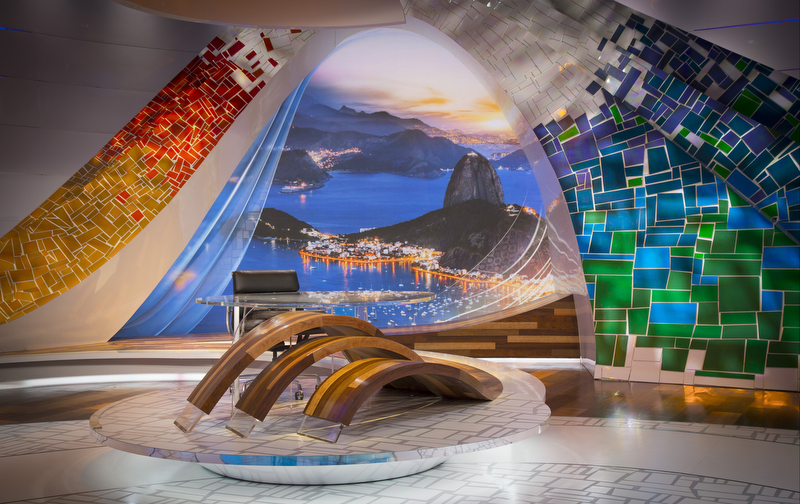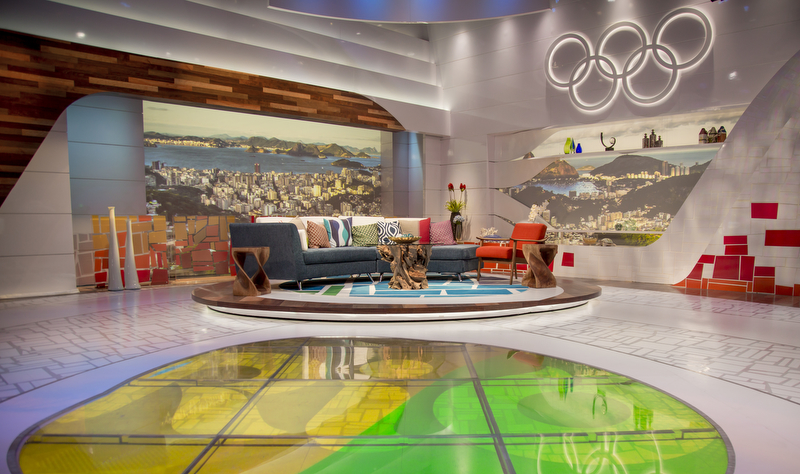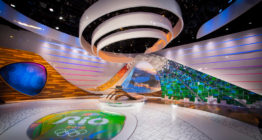Q&A: Delivering a unique view at the Olympics with Leyard LED walls

Subscribe to NCS for the latest news, project case studies and product announcements in broadcast technology, creative design and engineering delivered to your inbox.
NBC’s Summer Olympics coverage in Rio was unmatched in scale, with the network rolling out the latest in technology and fanfare across its multiple networks and streams.
The network’s studios, from Bryan Higgason’s HD Studio, featured designs that captured the spirit of Brazil with unique details and layers of visuals. Throughout the space, large video walls allowed views of the games and country to appear, helping connect viewers with the games.
We recently spoke with Jennifer Davis, CMO at Leyard, about the companies involvement with NBC’s studio display technology at the Olympics. Davis, a 20 year veteran of the company, leads Leyard’s marketing and product strategy.
What were some of the challenges of creating the unique, organic shapes that NBC’s design included?
The organic shapes of the walls on the set of the NBC coverage of the Olympics in Rio were achieved with the flexibility of the Leyard TVH Series displays, combined with finish carpentry to mask the edges of the displays. This added the smooth curves that you saw in the coverage, but also provided some dimensionality to the set itself.
How is creating a non-traditional shaped LED wall different than a simple square or rectangle one?
Any video wall that is created in a non-traditional video aspect ratio adds complexity to the installation. This is true whether the wall is square or extra wide or tall. These installations are fronted with a processor capable of driving content in aspect ratios other than 16:9 and require custom content.
Broadcast content is often driven off real-time graphics controllers that not only drive the wall from a software perspective but provide the flexibility to develop the story visuals in a fast-paced production environment.
What were some of the challenges with creating this to be used overseas and shipping and assembling on-site?
Our international customers, or those customers with international operations, are familiar with the challenges of staging, moving, and assembling products across countries and continents.
The Olympics brought to Rio a world of technology and talent. The expert team on the ground in Rio was able to take elements of the installation from international and local suppliers and build a unified set that served the needs of the viewing public.

Photos courtesy of NBC Sports Group
Which LED feature that you provided NBC are you most proud of and why?
The Leyard TVH product is the most popular fine pitch product in the history of the category for good reason. The compact 19.5” diagonal size (400mm x 300mm) LED cabinets are easy to handle and provide an exact fit for video walls of virtually any size or configuration. This is particularly useful on the NBC set where they didn’t want to waste pixels behind the wall facades.
The seamless design creates a contiguous canvas for storytelling without the distraction of black bezels cutting up the content. The Leyard TVH achieve high contrast imagery with a black resin MicroGrid Shader which enables the industry’s best black levels. This makes the colors of the screen pop and provides great uniformity, even off-axis (which is important on a set as large as the NBC set).

Example of Leyard panel back.
Here is a list of the Leyard products involved in the NBC Rio set:
- SugarLoaf wall: TVH 1.9mm pitch 13 wide by 13 tall (169 panels)
- Pebble wall: TVH 1.9mm pitch 8 wide by 7 tall (56 panels)
- Floor display: TVH 2.5mm 9 w by 12 tall (108 panels)
- Copacabana Beach Veranda: TVH 1.9mm 4 wide by 3 high (12 panels)
Structures, optical fiber cables, and video processing was provided by NBC.
Can you discuss the general price range of an installation in similar scope to this one?
Leyard has broadcast customers that spend a few thousand dollars up to hundreds of thousands of dollars, depending on the size, complexity, and needs of the studio design.
What is the importance of pixel pitch for broadcasters?
Pixel pitch, which is a measure of the pixel density or resolution-per-area of the wall, is critical to broadcasters. The fine pixel pitch technology of the
The fine pixel pitch technology of the Leyard TVH allowed for the creation of high-resolution video walls where the individual pixels were imperceptible to the camera and the viewers at home. This adds to the professionalism of the broadcast and reflects well the overall quality of the programming.
Why LED vs say RP or another technology?
In two words, bright seamlessness!
Rear projection technology, although a staple for years in demanding markets like control rooms, is relatively dim compared to the rear projection technology, although a staple for years in demanding markets like control rooms, is relatively dim compared to the Leyard LED product lines and has the disadvantage of having seams.
RP seams might be more diminutive and less visible than say the bezels of a tiled LCD video wall, but they are still there and will catch the bright studio lights and cause distraction.
Other video wall technologies have traditionally achieved higher pixel densities which lead to smoother graphics and more detailed information on the screens, but with the recent innovations in fine pitch or narrow pixel pitch LED and the typical camera distance in a studio, LED was the right choice for the application.
Subscribe to NCS for the latest news, project case studies and product announcements in broadcast technology, creative design and engineering delivered to your inbox.





tags
2016 Olympics, 2016 Summer Olympics, Brazil, LED, LED Displays, led wall, Leyard TVH, monitor wall, NBC, NBC Olympics, nbc sports group, pixel pitch, Planar, Rio de Janeiro, video wall
categories
Exclusives, Heroes, Olympics, Sports Broadcasting & Production, Sports Set Design, Studio Technology